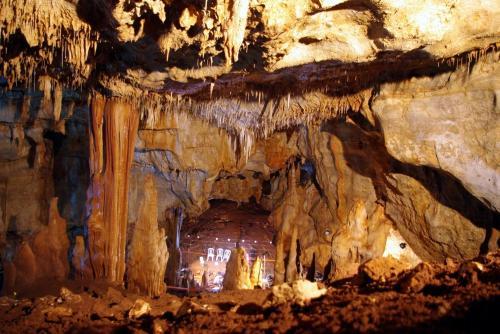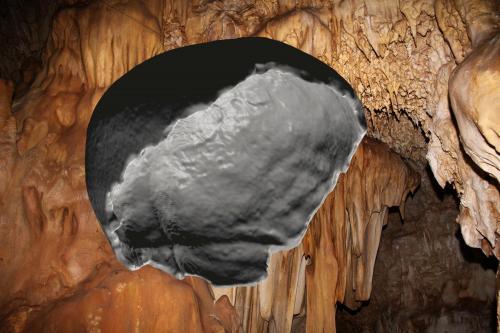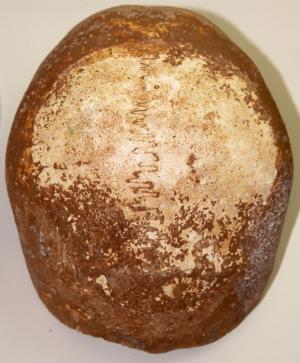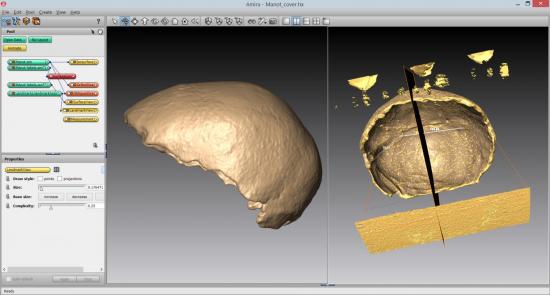Case Western Reserve University
Source - http://phys.org/news/2015-01-ancient-skull-galilee-cave-clues.html

Inside the Manot Cave in Israel's Galilee, where a 55,000-year-old skull sheds new light on modern human migration patterns. Credit: Amos Frumkin / Hebrew University Cave Research Center
Modern Europeans have inherited about 4 percent of their genes from Neanderthals, meaning the two groups mated at some point in the past. But the question is, where and when?
Characteristics of a partial skull recently discovered in Manot Cave in Israel's West Galilee provide the earliest evidence that modern humans co-inhabited the area with Neanderthals and could have met and interbred 55,000 years ago.
The finding—which challenges a previous hypothesis that the two species potentially met 45,000 years ago somewhere in Europe—is reported in the Advance Online Publication Nature article, "Levantine cranium from Manot Cave (Israel) foreshadows the First European modern humans."
"It has been suspected that modern man and Neanderthals were in the same place at the same time, but we didn't have the physical evidence. Now we do have it in the new skull fossil," said paleontologist Bruce Latimer, from Case Western Reserve University School of Dental Medicine's Department of Orthodontics.
The finding of Neanderthals living at other Levantine sites in the eastern Mediterranean region places the two species in the same area at about the same time. The Manot cave is located in the region where Neanderthals periodically lived, perhaps when ice sheets in Europe forced them to migrate to warmer locales, like the Levant region.
Manot is a prehistoric cave with an impressive archaeological sequence and spectacular speleothems. To date, five excavation seasons (2010-2014) have been conducted in the cave on behalf of the Israel Antiquities Authority, Tel Aviv University and Ben-Gurion University of the Negev. The cave is situated along the only land route available for ancient humans to travel out of Africa to the Middle East, Asia and Europe.

The interior of the Manot Cave in Israel's Galilee, where a 55,000-year-old skull sheds new light on modern human migration patterns. Credit: Amos Frumkin / Hebrew University Cave Research Center
"Modern humans and Neanderthals likely encountered each other foraging for food," Latimer said.
Latimer and Mark Hans, chair of CWRU's Department of Orthodontics, were among a team of researchers that worked closely with the study's lead investigator Israel Hershkovitz, professor of anatomy and anthropology at Tel Aviv University.
The partial cranium, covered in a patina of minerals produced by the wet conditions within the cave, allowed Miryam Bar-Matthews , Avner Ayalon and Gal Yas'ur from the Geological Survey of Israel to use uranium-thorium dating techniques and determine that the skull was between 50,000 to 60,000 years old.

The computer-tomographic version of the Manot specimen and the Manot Cave in the background are depicted. Credit: Copyright: Gerhard Weber
Latimer said the skull contained a relatively small brain of around 1,100 milliliters. (The modern human brain averages around 1,400 milliliters.)
Several features of the cranium resemble modern man's skull, Latimer said. In particular, he was interested in the cranium's bony formation called the occipital bun on the back of the skull. While its purpose is unknown, the Neanderthal's bun looks much like a bony hot dog bun with a groove down the center. This feature was absent in the Manot fossil, and is also typically missing in modern humans.
The fossil's gender is unknown because it's missing the brow ridge, one marker for gender differences. Because the skull is from an adult, CWRU researchers know it is not related to other sub-adult human teeth and bones also found in the cave, according to Hans.
"This leads us to believe that there are likely more fossils in the cave where other bones associated with the skull might be found," Hans said.
Latimer became involved in the project after receiving an invitation from Hershkovitz to examine the fossil skull, discovered in 2008 by spelunkers who had rappelled through a newly opened roof of the previously unknown cave that had been sealed for 30,000 years.

The Manot calotte (original) is in the top view. Well visible are the skull sutures and the brownish calcite patina. Credit: Copyright: Gerhard Weber
Under the direction of former dental school Dean Jerold Goldberg, Case Western Reserve formed a 10-year partnership with Israel Antiquities Authority and Tel Aviv University in 2012 to excavate the cave. As a result of this partnership, Latimer joined Hans to expand the scope of orthodontic research on craniofacial growth and development to include human evolution. The Manot Cave project also is part of Case Western Reserve's initiative, called the Institute for the Science of Origins (ISO).

The Manot specimen is on the computer screen, in lateral view (left) and from inside (right). Credit: Copyright: Gerhard Weber
"Who we are, where we came from and how we got here are questions that have fascinated us humans since before there was history," said Glenn Starkman, director of ISO and professor of physics, who studies origins of the universe. "We weaved wondrous myths that answered those questions definitively, but now we slowly accumulate evidence from the distant past. This process lies at the heart of the origins sciences, and the Institute for the Science of Origins celebrates the unique interdisciplinary collaboration that its fellows from the School of Dental Medicine deployed to uncover more of the story behind humanity's departure from Africa for the world beyond."
More information: Levantine cranium from Manot Cave (Israel) foreshadows the first European modern humans, Nature, DOI: 10.1038/nature14134